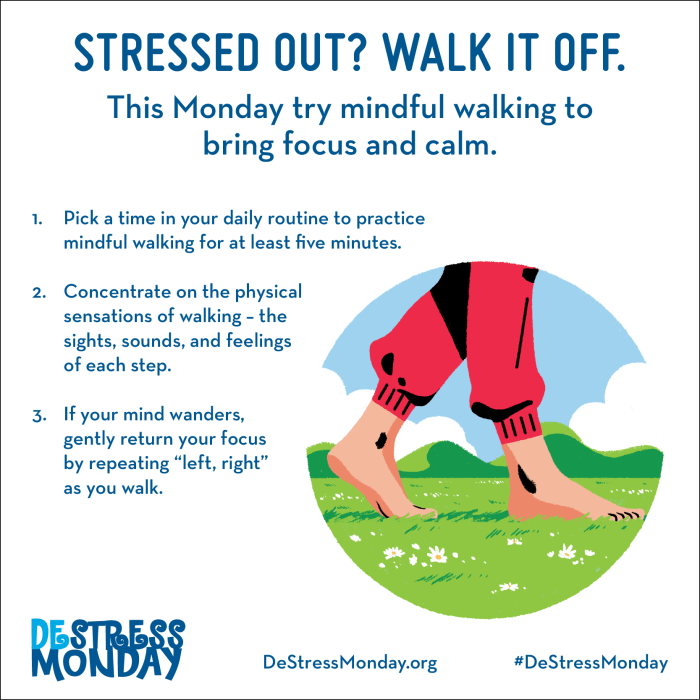Embark on a journey into the realm of walking meditation for mindfulness, where tranquility and awareness intertwine harmoniously. Discover the art of walking with purpose and presence, enriching your mental landscape with each step taken.
Learn the techniques, embrace the challenges, and seamlessly integrate this practice into your daily routine for a profound sense of well-being and self-discovery.
Introduction to Walking Meditation

Source: wholeself.yoga
Walking meditation is a form of mindfulness practice that involves being fully present and aware while walking. The purpose of walking meditation is to cultivate a sense of inner peace, focus, and connection to the present moment.
Unlike traditional sitting meditation where you are seated in one place, walking meditation involves moving slowly and mindfully, paying attention to each step and the sensations in your body as you walk. It is a way to practice mindfulness in motion.
Benefits of Practicing Walking Meditation
- Improves concentration and focus.
- Increases awareness of your surroundings.
- Helps to reduce stress and anxiety.
- Promotes a sense of calm and relaxation.
- Enhances mind-body connection.
Techniques for Walking Meditation

Source: choosingtherapy.com
Walking meditation involves a specific set of techniques to help practitioners cultivate mindfulness, focus, and awareness while moving. Proper posture, pace, breath synchronization, and sensory awareness are essential components of this practice.
Proper Posture and Pace
- Begin by standing tall with your shoulders relaxed and your gaze directed slightly ahead.
- Keep a steady and moderate pace, allowing your movements to flow naturally without rushing.
- Ensure your arms are gently bent at the elbows, with your hands lightly clasped in front or resting at your sides.
- Focus on maintaining a sense of balance and stability as you walk, feeling each step connecting you to the ground.
Synchronize Breath with Each Step
- Start by taking a few deep breaths to center yourself before beginning the walking meditation.
- As you start walking, synchronize your breath with your steps, inhaling for a certain number of steps and exhaling for the same number.
- Focus on the rhythm of your breath and steps, allowing them to create a sense of harmony and mindfulness in your movement.
- Continue this synchronized breathing pattern throughout your walking meditation to stay present and focused.
Focus on Sensations While Walking Mindfully
- Direct your attention to the sensations in your body as you walk, noticing the subtle movements and feelings with each step.
- Observe the contact of your feet with the ground, the shifting of weight from one foot to the other, and the sensations of movement in your legs and hips.
- Stay present and aware of any thoughts or distractions that arise, gently guiding your focus back to the sensations of walking.
- Engage all your senses in the experience, noticing the sounds, smells, and sights around you without judgment.
Creating a Mindful Environment
When engaging in walking meditation for mindfulness, creating a suitable environment is crucial to enhance the experience and focus on the present moment.
Choosing a Suitable Location
- Select a quiet and peaceful location free from distractions such as loud noises or heavy foot traffic.
- Opt for natural settings like parks, forests, or beaches to connect with nature and promote a sense of calmness.
- Ensure the area is safe and free from obstacles to allow for uninterrupted walking.
Minimizing Distractions
- Turn off electronic devices or put them on silent mode to avoid interruptions during the practice.
- Avoid choosing crowded places or routes with high levels of activity to maintain focus on the meditation.
- Dress comfortably and appropriately for the weather to prevent discomfort that could break concentration.
Enhancing the Experience with Natural Surroundings
- Immerse yourself in the beauty of nature to amplify the benefits of walking meditation.
- Observe the sights, sounds, and sensations of the natural environment to deepen mindfulness and presence.
- Allow nature to be your guide and source of inspiration as you walk mindfully in harmony with the surroundings.
Overcoming Challenges in Walking Meditation

Source: mondaycampaigns.org
When practicing walking meditation, there are common obstacles that may arise, hindering your ability to stay present and focused. It is important to acknowledge these challenges and have strategies in place to overcome them effectively.
Dealing with Wandering Thoughts
- Acknowledge the thought: When a wandering thought enters your mind, acknowledge it without judgment. Simply label it as a thought and gently guide your attention back to your walking.
- Focus on your steps: Shift your attention to the sensations of walking – the lifting, moving, and placing of each foot. This can help anchor you in the present moment.
- Use a mantra: If thoughts persist, you can repeat a calming phrase or mantra to yourself while walking. This can help redirect your focus away from distractions.
Maintaining Focus and Presence
- Breath awareness: Pay attention to your breath as you walk. Feel the inhale and exhale, and use it as a reminder to stay present in the moment.
- Body scan: Periodically scan your body from head to toe while walking. Notice any tension or discomfort and consciously release it, bringing yourself back to the present.
- Slow down: If you find yourself rushing or losing focus, intentionally slow down your pace. This can help you tune into each movement and stay grounded in the experience.
Integrating Walking Meditation into Daily Routine

Source: mindful.org
Integrating walking meditation into your daily routine can help you cultivate mindfulness consistently and experience its benefits. Here are some practical tips to make this practice a regular part of your day:
Ideal Frequency and Duration
It is recommended to practice walking meditation for at least 10-15 minutes a day to experience its full benefits. You can start with shorter sessions and gradually increase the duration as you become more comfortable with the practice.
Practical Tips for Busy Schedules
- Choose a specific time of day when you can dedicate a few minutes to walking meditation, such as early morning or during a lunch break.
- Integrate walking meditation into activities you already do daily, such as walking to work or taking a stroll in the park.
- Use walking meditation as a transition between tasks to reset your mind and focus before moving on to the next activity.
Gradually Increasing Duration or Intensity
To gradually increase the duration or intensity of your walking meditation practice, consider the following:
- Extend the duration of each walking meditation session by a few minutes every week to challenge yourself gradually.
- Focus on increasing your awareness and presence during each step, rather than just the physical distance covered.
- Experiment with different walking speeds or environments to add variety and challenge to your practice.
Closure

Source: carolinejordanfitness.com
In conclusion, walking meditation for mindfulness offers a transformative experience that nurtures the mind, body, and spirit. Embrace this practice as a cornerstone of your inner growth journey, paving the way for a more mindful and fulfilling existence.